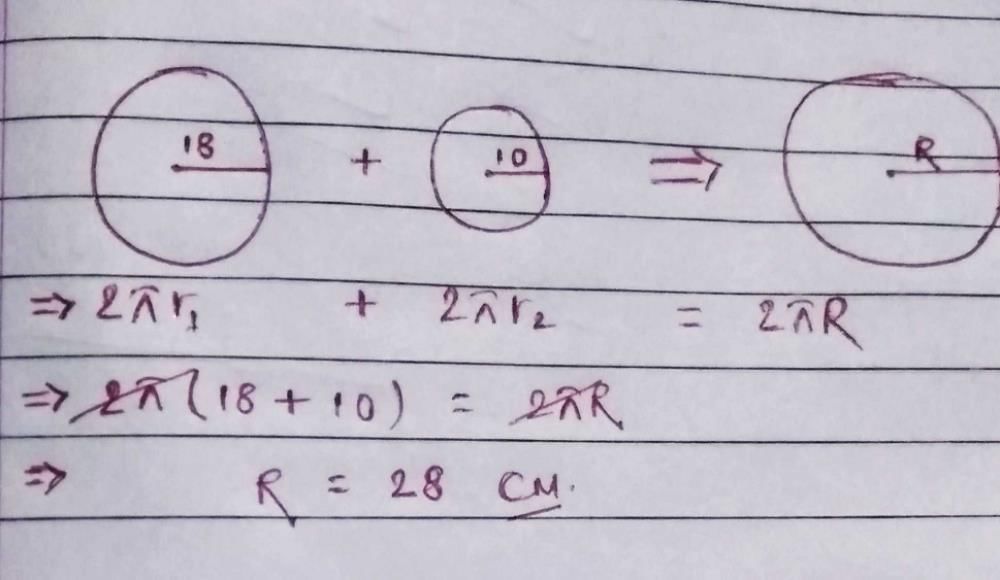Class 10 Exam > Class 10 Questions > The radius of a circle whose circumference is...
Start Learning for Free
The radius of a circle whose circumference is equal to the sum of the circumferences of the two circles of diameters 36 cm and 20 cm is
- a)56 cm
- b)42 cm
- c)28 cm
- d)16 cm
Correct answer is option 'C'. Can you explain this answer?
Most Upvoted Answer
The radius of a circle whose circumference is equal to the sum of the ...
Diameter of first circle = d1 = 36 cm
Diameter of second circle = d2 = 20 cm
∴ Circumference of first circle = πd1 = 36π cm
Circumference of second circle = πd2 = 20π cm
Now, we are given that,
Circumference of circle = Circumference of first circle + Circumference of second circle
πD = πd1 + πd2
⇒ πD = 36π + 20π
⇒ πD = 56π ⇒ D = 56
⇒ Radius = 56/2 = 28 cm
Diameter of second circle = d2 = 20 cm
∴ Circumference of first circle = πd1 = 36π cm
Circumference of second circle = πd2 = 20π cm
Now, we are given that,
Circumference of circle = Circumference of first circle + Circumference of second circle
πD = πd1 + πd2
⇒ πD = 36π + 20π
⇒ πD = 56π ⇒ D = 56
⇒ Radius = 56/2 = 28 cm
Free Test
FREE
| Start Free Test |
Community Answer
The radius of a circle whose circumference is equal to the sum of the ...


|
Explore Courses for Class 10 exam
|

|
Question Description
The radius of a circle whose circumference is equal to the sum of the circumferences of the two circles of diameters 36 cm and 20 cm isa)56 cmb)42 cmc)28 cmd)16 cmCorrect answer is option 'C'. Can you explain this answer? for Class 10 2025 is part of Class 10 preparation. The Question and answers have been prepared according to the Class 10 exam syllabus. Information about The radius of a circle whose circumference is equal to the sum of the circumferences of the two circles of diameters 36 cm and 20 cm isa)56 cmb)42 cmc)28 cmd)16 cmCorrect answer is option 'C'. Can you explain this answer? covers all topics & solutions for Class 10 2025 Exam. Find important definitions, questions, meanings, examples, exercises and tests below for The radius of a circle whose circumference is equal to the sum of the circumferences of the two circles of diameters 36 cm and 20 cm isa)56 cmb)42 cmc)28 cmd)16 cmCorrect answer is option 'C'. Can you explain this answer?.
The radius of a circle whose circumference is equal to the sum of the circumferences of the two circles of diameters 36 cm and 20 cm isa)56 cmb)42 cmc)28 cmd)16 cmCorrect answer is option 'C'. Can you explain this answer? for Class 10 2025 is part of Class 10 preparation. The Question and answers have been prepared according to the Class 10 exam syllabus. Information about The radius of a circle whose circumference is equal to the sum of the circumferences of the two circles of diameters 36 cm and 20 cm isa)56 cmb)42 cmc)28 cmd)16 cmCorrect answer is option 'C'. Can you explain this answer? covers all topics & solutions for Class 10 2025 Exam. Find important definitions, questions, meanings, examples, exercises and tests below for The radius of a circle whose circumference is equal to the sum of the circumferences of the two circles of diameters 36 cm and 20 cm isa)56 cmb)42 cmc)28 cmd)16 cmCorrect answer is option 'C'. Can you explain this answer?.
Solutions for The radius of a circle whose circumference is equal to the sum of the circumferences of the two circles of diameters 36 cm and 20 cm isa)56 cmb)42 cmc)28 cmd)16 cmCorrect answer is option 'C'. Can you explain this answer? in English & in Hindi are available as part of our courses for Class 10.
Download more important topics, notes, lectures and mock test series for Class 10 Exam by signing up for free.
Here you can find the meaning of The radius of a circle whose circumference is equal to the sum of the circumferences of the two circles of diameters 36 cm and 20 cm isa)56 cmb)42 cmc)28 cmd)16 cmCorrect answer is option 'C'. Can you explain this answer? defined & explained in the simplest way possible. Besides giving the explanation of
The radius of a circle whose circumference is equal to the sum of the circumferences of the two circles of diameters 36 cm and 20 cm isa)56 cmb)42 cmc)28 cmd)16 cmCorrect answer is option 'C'. Can you explain this answer?, a detailed solution for The radius of a circle whose circumference is equal to the sum of the circumferences of the two circles of diameters 36 cm and 20 cm isa)56 cmb)42 cmc)28 cmd)16 cmCorrect answer is option 'C'. Can you explain this answer? has been provided alongside types of The radius of a circle whose circumference is equal to the sum of the circumferences of the two circles of diameters 36 cm and 20 cm isa)56 cmb)42 cmc)28 cmd)16 cmCorrect answer is option 'C'. Can you explain this answer? theory, EduRev gives you an
ample number of questions to practice The radius of a circle whose circumference is equal to the sum of the circumferences of the two circles of diameters 36 cm and 20 cm isa)56 cmb)42 cmc)28 cmd)16 cmCorrect answer is option 'C'. Can you explain this answer? tests, examples and also practice Class 10 tests.

|
Explore Courses for Class 10 exam
|

|
Signup for Free!
Signup to see your scores go up within 7 days! Learn & Practice with 1000+ FREE Notes, Videos & Tests.



















